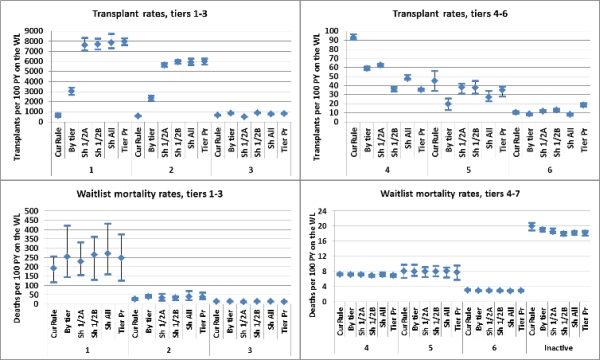Thoracic Simulated Allocation Modeling (TSAM) of Broader Sharing.
1SRTR, Minneapolis, MN
2UNOS, Richmond, VA
3Florida Hospital Transplant Institute, Orlando, FL
4Nemours/A.I. duPont Hospital for Children, Wilmington, DE
5Columbia University Medical Center, New York, NY
6Duke University, Durham, NC.
Meeting: 2016 American Transplant Congress
Abstract number: C71
Keywords: Allocation, Heart
Session Information
Session Name: Poster Session C: Economics, Public Policy, Allocation, Ethics
Session Type: Poster Session
Date: Monday, June 13, 2016
Session Time: 6:00pm-7:00pm
 Presentation Time: 6:00pm-7:00pm
Presentation Time: 6:00pm-7:00pm
Location: Halls C&D
Heart allocation policy (OPTN policy 6) is in development. The Heart Subcommittee of the OPTN Thoracic Committee developed a 6-tiered medical urgency algorithm, then investigated 4 broader geographic sharing strategies. We determined the impact of modified geographic orderings on transplant rates and mortality rates.
Using TSAM software and OPTN data, we determined the relative impact of 4 geographic orderings, using a 6-tiered medical urgency algorithm, on transplant rates and on waitlist and posttransplant mortality rates. Results were compared with the current allocation rules and allocation under the 6-tier urgency algorithm. The study included 8885 heart and 141 heart-lung candidates listed for at least 1 day from July 1, 2009-June 30, 2011.
Simulations of broader sharing showed substantially higher transplant rates in the sickest candidates (tiers 1 and 2) but slightly lower rates across all tiers. It produced lower waitlist mortality rates than simulation using current rules, but similar posttransplant mortality rates. Transplant rates increased from 615 per 100 pt-yrs under current rules to 3044 under allocation by tiers, to 7627-7999 under the 4 broader sharing rules in tier-1 candidates. Corresponding increases in tier-2 candidates were 589 to 2363 to 5647-5996 (Figure). In tiers 1-6, waitlist mortality under broader sharing was similar to current rules. Broader sharing decreased waitlist deaths among inactive candidates, contributing to overall lower waitlist mortality.
Broader sharing showed substantially higher transplant rates in the sickest candidates than current allocation rules and than allocation by tiers under current geographical ordering. Overall waitlist morality rates were lower and posttransplant mortality rates were similar. Broader sharing may increase transplants in the most critically ill patients while decreasing waitlist mortality.

CITATION INFORMATION: Colvin M, Skeans M, Robbins Callahan L, Edwards L, Zeglin J, Silvestry S, Davies R, Farr M, Israni A, Rogers J. Thoracic Simulated Allocation Modeling (TSAM) of Broader Sharing. Am J Transplant. 2016;16 (suppl 3).
To cite this abstract in AMA style:
Colvin M, Skeans M, Callahan LRobbins, Edwards L, Zeglin J, Silvestry S, Davies R, Farr M, Israni A, Rogers J. Thoracic Simulated Allocation Modeling (TSAM) of Broader Sharing. [abstract]. Am J Transplant. 2016; 16 (suppl 3). https://atcmeetingabstracts.com/abstract/thoracic-simulated-allocation-modeling-tsam-of-broader-sharing/. Accessed December 27, 2025.« Back to 2016 American Transplant Congress
